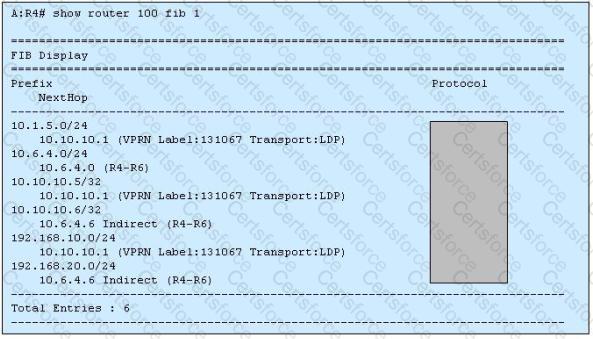On which component is vc-type configured to create an E-pipe service that preserves the VLAN tag during transport?
A VPRN service is configured with BGP used as the CE-PE routing protocol. What address families are required on the PE-CE BGP session?
Service tunnels and transport tunnels are bidirectional and only require the operator to configure the tunnel on one router.
If the Alcatel-Lucent 7750 SR is rebooted after an "admin save'' has been performed, which of the following about mirror services is TRUE?
What is the purpose of service mirroring on the Alcatel-Lucent Service Router?
Which protocol is used to signal the service label for a Layer 3 VPRN service?
An IPv4 MPLS provider network is being configured for 6VPE. BGP is being used for the PE-CE protocol to exchange IPv6 routes. Which of the following is FALSE?
An E-pipe is configured with a service MTU of 5000. What MTU value should be set on the access port for a Q-in-Q encapsulated SAP?
By default, what does the Alcatel-Lucent 7750 SR do when a frame with an unknown destination address is received in a VPLS?
Which of the following statements about SAPs that are part of a VPVVS is FALSE?
In a Layer 2 encapsulation using T-LDP, what does the second (bottom) label represent?
How many service labels must be signaled to bring up a fully-meshed VPLS among three PE routers?
Which of the following is TRUE when a service uses a GRE transport tunnel?
In a Layer 2 encapsulation using T-LDP, what does the first (top) label represent?
A Cpipe supports both structured and unstructured frames.
Which of the following best describes the flooding of traffic on a PE when unknown traffic is received on a SAP of a VPLS?
Click the exhibit.

The output is from PE router R4 about VPRN service 100. How many prefixes have been learned from the MP-BGP protocol?
On an Alcatel-Lucent 7750 SR, why must the MTU be explicitly set when configuring an IES spoke termination to a VPLS?
On an Alcatel-Lucent 7750 SR, which of the following about IES interfaces is FALSE?
An operator wishes to verify end-to-end connectivity for an individual service. What utility will he or she most likely use?